Gangster
A gangster is a criminal who is a member of a gang. Some gangs are considered to be part of organized crime. Gangsters are also called mobsters, a term derived from mob and the suffix -ster.[1] Gangs provide a level of organization and resources that support much larger and more complex criminal transactions than an individual criminal could achieve. Gangsters have been active for many years in countries around the world. Gangsters are the subject of many novels, films, and video games.
Etymology
Some contemporary criminals refer to themselves as "gangsta" in reference to non-rhotic black American pronunciation.
Gangs

In today's usage, the term "gang" is generally used for a criminal organization, and the term "gangster" invariably describes a criminal.[2] Much has been written on the subject of gangs, although there is no clear consensus about what constitutes a gang or what situations lead to gang formation and evolution. There is agreement that the members of a gang have a sense of common identity and belonging, and this is typically reinforced through shared activities and through visual identifications such as special clothing, tattoos or rings.[3] Some preconceptions may be false. For example, the common view that illegal drug distribution in the United States is largely controlled by gangs has been questioned.[4]
A gang may be a relatively small group of people who cooperate in criminal acts, as with the Jesse James gang, which ended with the leader's death in 1882. But a gang may be a larger group with a formal organization that survives the death of its leader. The Chicago Outfit created by Johnny Torrio and Al Capone outlasted its founders and survived into the 21st century. Large and well structured gangs such as the Mafia, drug cartels, Triads or even outlaw motorcycle gangs can undertake complex transactions that would be far beyond the capability of one individual, and can provide services such as dispute arbitration and contract enforcement that parallel those of a legitimate government.[5]
The term "organized crime" is associated with gangs and gangsters, but is not synonymous. A small street gang that engages in sporadic low-level crime would not be seen as "organized". An organization that coordinates gangs in different countries involved in the international trade in drugs or prostitutes may not be considered a "gang".[6]
Although gangs and gangsters have existed in many countries and at many times in the past, they have played more prominent roles during times of weakened social order or when governments have attempted to suppress access to goods or services for which there is a high demand.
Regional variants
Europe
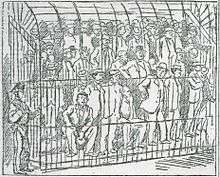
The Sicilian Mafia, or Cosa Nostra is a criminal syndicate that emerged in the mid-nineteenth century in Sicily, Italy. It is a loose association of criminal groups that share common organizational structure and code of conduct. The origins lie in the upheaval of Sicily's transition out of feudalism in 1812 and its later annexation by mainland Italy in 1860. Under feudalism, the nobility owned most of the land and enforced law and order through their private armies. After 1812, the feudal barons steadily sold off or rented their lands to private citizens. Primogeniture was abolished, land could no longer be seized to settle debts, and one fifth of the land was to become private property of the peasants.[7]
Organized crime has existed in Russia since the days of Imperial Russia in the form of banditry and thievery. In the Soviet period Vory v Zakone emerged, a class of criminals that had to abide by certain rules in the prison system. One such rule was that cooperation with the authorities of any kind was forbidden. During World War II some prisoners made a deal with the government to join the armed forces in return for a reduced sentence, but upon their return to prison they were attacked and killed by inmates who remained loyal to the rules of the thieves.[8] In 1988 the Soviet Union legalized private enterprise but did not provide regulations to ensure the security of market economy. Crude markets emerged, the most notorious being the Rizhsky market where prostitution rings were run next to the Rizhsky Railway Station in Moscow.[9]
As the Soviet Union headed for collapse many former government workers turned to crime, while others moved overseas. Former KGB agents and veterans of the Afghan and First and Second Chechen Wars, now unemployed but with experience that could prove useful in crime, joined the increasing crime wave.[9] At first, the Vory v Zakone played a key role in arbitrating the gang wars that erupted in the 1990s.[10] By the mid-1990s it was believed that "Don" Semion Mogilevich had become the "boss of all bosses" of most Russian Mafia syndicates in the world, described by the British government as "one of the most dangerous men in the world".[11] More recently, criminals with stronger ties to big business and the government have displaced the Vory from some of their traditional niches, although the Vory are still strong in gambling and the retail trade.[10]
The Albanian Mafia is active in Albania, the United States, and the European Union (EU) countries, participating in a diverse range of criminal enterprises including drug and arms trafficking.[12][13] The people of the mountainous country of Albania have always had strong traditions of family and clan loyalty, in some ways similar to that of southern Italy. Ethnic Albanian gangs have grown rapidly since 1992 during the prolonged period of instability in the Balkans after the collapse of Yugoslavia. This coincided with large scale migration throughout Europe and to the United States and Canada. Although based in Albania, the gangs often handle international transactions such as trafficking in economic migrants, drugs and other contraband, and weapons.[14] Other criminal organizations that emerged in the Balkans around this time are popularly called the Serbian Mafia, Bosnian Mafia, Bulgarian Mafia and so on.
Asia
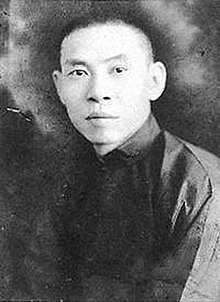
In China, Triads trace their roots to resistance or rebel groups opposed to Manchu rule during the Qing dynasty, which were given the triangle as their emblem.[15] The first record of a triad society, Heaven and Earth Gathering, dates to the Lin Shuangwen uprising on Taiwan from 1786 to 1787.[16] The triads evolved into criminal societies. When the Chinese Communist Party came to power in 1949 in mainland China, law enforcement became stricter and tough governmental crackdown on criminal organizations forced the triads to migrate to Hong Kong, then a British colony, and other cities around the world. Triads today are highly organized, with departments responsible for functions such as accounting, recruiting, communications, training and welfare in addition to the operational arms. They engage in a variety of crimes including extortion, money laundering, smuggling, trafficking and prostitution.[17]
Yakuza are members of traditional organized crime syndicates in Japan. They are notorious for their strict codes of conduct and very organized nature. As of 2009 they had an estimated 80,900 members.[18] Most modern yakuza derive from two classifications which emerged in the mid-Edo period: tekiya, those who primarily peddled illicit, stolen or shoddy goods; and bakuto, those who were involved in or participated in gambling.[19]
United States and Canada
As American society and culture developed, new immigrants were relocating to the United States. The first major gangs in 19th century New York City were the Irish gangs such as the Whyos and the Dead Rabbits.[20] These were followed by the Italian Five Points Gang and later a Jewish gang known as the Eastman Gang.[21][22] There were also "Nativist" anti-immigration gangs such as the Bowery Boys. The American Mafia arose from offshoots of the Mafia that emerged in the United States during the late nineteenth century, following waves of emigration from Sicily. There were similar offshoots in Canada among Italian Canadians.
In the later 1860s many Chinese emigrated to the United States, escaping from insecurity and economic hardship at home, at first working on the west coast and later moving east. The new immigrants formed Chinese Benevolent Associations. In some cases these evolved into Tongs, or criminal organizations primarily involved in gambling. Members of Triads who migrated to the United States often joined these tongs. With a new wave of migration in the 1960s, street gangs began to flourish in major cities. The tongs recruited these gangs to protect their extortion, gambling and narcotics operations.[23]
The terms "gangster" and "mobster" are mostly used in the United States to refer to members of criminal organizations associated with Prohibition or with an American offshoot of the Italian Mafia (such as the Chicago Outfit, the Philadelphia Mafia, or the Five Families). In 1920, the Eighteenth Amendment of the United States Constitution banned the sale, manufacture, and transportation of alcohol for consumption. Many gangs sold alcohol illegally for tremendous profit, and used acute violence to stake turf and protect their interest. Often, police officers and politicians were paid off or extorted to ensure continued operation.[24]
Latin America
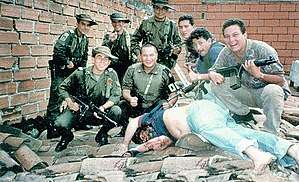
Most cocaine is grown and processed in South America, particularly in Colombia, Bolivia, Peru, and smuggled into the United States and Europe, the United States being the world's largest consumer of cocaine.[25] Colombia is the world's leading producer of cocaine, and also produces heroin that is mostly destined for the US market.[26] The Medellín Cartel was an organized network of drug suppliers and smugglers originating in the city of Medellín, Colombia. The gang operated in Colombia, Bolivia, Peru, Central America, the United States, as well as Canada and Europe throughout the 1970s and 1980s. It was founded and run by Ochoa Vázquez brothers with Pablo Escobar. By 1993, the Colombian government, helped by the US, had successfully dismantled the cartel by imprisoning or hunting and gunning down its members.[27]
Although Mexican drug cartels, or drug trafficking organizations, have existed for several decades, they have become more powerful since the demise of Colombia's Cali and Medellín cartels in the 1990s. Mexican drug cartels now dominate the wholesale illicit drug market in the United States.[28] Sixty five percent of cocaine enters the United States through Mexico, and the vast majority of the rest enters through Florida. Cocaine shipments from South America transported through Mexico or Central America are generally moved over land or by air to staging sites in northern Mexico. The cocaine is then broken down into smaller loads for smuggling across the U.S.–Mexico border.[29] Arrests of key gang leaders, particularly in the Tijuana and Gulf cartels, have led to increasing drug violence as gangs fight for control of the trafficking routes into the United States.[30]
Cocaine traffickers from Colombia, and recently Mexico, have also established a labyrinth of smuggling routes throughout the Caribbean, the Bahama Island chain, and South Florida. They often hire traffickers from Mexico or the Dominican Republic to transport the drug. The traffickers use a variety of smuggling techniques to transfer their drug to U.S. markets. These include airdrops of 500–700 kg in the Bahama Islands or off the coast of Puerto Rico, mid-ocean boat-to-boat transfers of 500–2,000 kg, and the commercial shipment of tonnes of cocaine through the port of Miami. Another route of cocaine traffic goes through Chile, this route is primarily used for cocaine produced in Bolivia since the nearest seaports lie in northern Chile. The arid Bolivia-Chile border is easily crossed by 4x4 vehicles that then head to the seaports of Iquique and Antofagasta.
Notorious individuals
Johnny Torrio
.jpg)
Born in southern Italy in 1882, Torrio immigrated to the United States with his mother after his father's death, which happened when he was three years old. Known as "The Fox" for his cunning, he helped the formation of the Chicago Outfit and he is credited for inspiring the birth of the National Crime Syndicate.[31] He was a big influence on Al Capone, who regarded him as a mentor.[32] After the assassination of Big Jim Colosimo, Torrio took his place in the Chicago Outfit. He was severely wounded by members of the North Side Gang while returning from a shopping trip, forcing him, along with other problems, to quit the criminal activity. He died in 1957 and the media learned about his death three weeks after his burial.[33] Elmer Irey, official of the United States Treasury Department, defined Torrio "the biggest gangster in America", "the smartest and the best of all the hoodlums"[34] while Virgil W. Peterson of the Chicago Crime Commission considered him "an organizational genius".[35]
Lucky Luciano
Charles Lucky Luciano born Salvatore Lucania[36] [salvaˈtoːre lukaˈniːa];[37] November 24, 1897 – January 26, 1962) was probably the most influential Mafia boss, he was an Italian-born mobster, criminal mastermind, and crime boss who operated mainly in the United States. Along with his associates, he was instrumental in the development of the National Crime Syndicate. Luciano is the father of modern organized crime in the United States for the establishment of The Commission in 1931. His crime family was later renamed the Genovese crime family.[38]
Al Capone
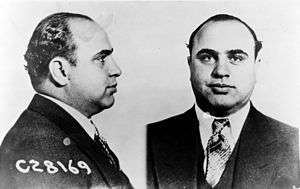
Al Capone was one of the most famous gangsters during the roaring twenties. Born in Williamsburg, Brooklyn in 1899 to immigrant parents, Capone was recruited by members of the Five Points Gang in the early 1920s. Capone's childhood friend, Lucky Luciano, was also originally a member of the Five Points Gang. Capone would rise to control a major portion of illicit activity such as gambling, prostitution, and bootlegging in Chicago during the early twentieth century.[39]
Frank Costello
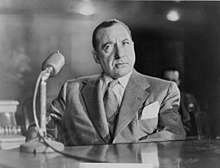
Frank Costello was an influential gangster. He was born in southern Italy but moved to America when he was four years old. He later changed his name from Francesco Castiglia to Frank Costello when he joined a gang at age 13. His name change led some people to mistakenly believe he was Irish. He worked for Charlie Luciano and was in charge of bootlegging and gambling. He was also the Luciano gangs emissary to politicians, he later held sway over politicians which enabled him political protection to continue his business. He took charge of Lucianos gang when Lucky Luciano was arrested, during his time in power he expanded the gang's operations into white collar crimes. He decided to step down from power when Vito Genovese returned from Italy and challenged him for power to run the Luciano crime family. Costello retired from the gangster life style and died peacefully in 1973.
Carlo Gambino
Carlo Gambino was an influential gangster in America. From 1961 until he died in 1976, he was known for being very low key. Gambino was born in Palermo, Sicily, but moved to the United States at the age of 21. Through his relatives the Castellano, he joined the Masseria Family while Lucky Luciano was the underboss in the Masseria Family, Gambino worked for him. After Luciano had Masseria killed, Luciano became the boss, and Gambino was sent by Luciano to the Scalise Family. Later Scalise was stripped of his rank, and Vincenzo Mangano became boss until 1951, when Mangano disappeared. His body was never found. Gambino then worked his way up the ladder to be the last known boss to have full control of the commission besides Luciano. Gambino was known to have taken the Mafia out of the lime light and kept it in the dark and away from the media. [40]
In popular culture
Gangs have long been the subject of movies. In fact, the first feature-length movie ever produced was The Story of the Kelly Gang (1906), an Australian production that traced the life of the outlaw Ned Kelly (1855–1880).[41] The United States has profoundly influenced the genre, but other cultures have contributed distinctive and often excellent gangster movies.
United States
The classic gangster movie ranks with the Western as one of the most successful creations of the American movie industry. The "classic" form of gangster movie, rarely produced in recent years, tells of a gangster working his way up through his enterprise and daring, until his organization collapses while he is at the peak of his powers. Although the ending is presented as a moral outcome, it is usually seen as no more than an accidental failure. The gangster is typically articulate, although at times lonely and depressed, and his worldly wisdom and defiance of social norms has a strong appeal, particularly to adolescents.[42]
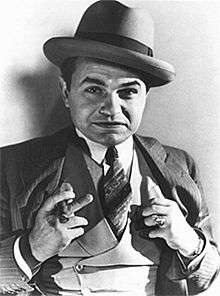
The stereotypical image and myth of the American gangster is closely associated with organized crime during the Prohibition era of the 1920s and 1930s.[43]
The years 1931 and 1932 saw the genre produce three classics: Warner Bros.' Little Caesar and The Public Enemy, which made screen icons out of Edward G. Robinson and James Cagney, and Howard Hughes' Scarface starring Paul Muni, which offered a dark psychological analysis of a fictionalized Al Capone.[44] These films chronicle the quick rise, and equally quick downfall, of three young, violent criminals, and represent the genre in its purest form before moral pressure would force it to change and evolve. Though the gangster in each film would face a violent downfall which was designed to remind the viewers of the consequences of crime, audiences were often able to identify with the charismatic anti-hero. Those suffering from the Depression were able to relate to the gangster character who worked hard to earn his place and success in the world, only to have it all taken away from him.[45]
Latin America
Latin American gangster movies are known for their gritty realism. Soy un delincuente (English: I Am a Criminal) is a 1976 Venezuelan film by director Clemente de la Cerda. The film tells the story of Ramón Antonio Brizuela, a real-life individual, who since childhood has to deal with rampant violence and the drugs, sex and petty thievery of a Caracas slum. Starting with delinquency, Ramón moves on to serious gang activity and robberies. He grows into a tough, self-confident young man who is hardened to violence. His views change when his fiancée's brother is killed in a robbery. The film was a blockbuster hit in Venezuela.[46]
City of God (Portuguese: Cidade de Deus) is a 2002 Brazilian crime drama film directed by Fernando Meirelles and co-directed by Kátia Lund, released in its home country in 2002 and worldwide in 2003. All the characters existed in reality, and the story is based on real events. It depicts the growth of organized crime in the Cidade de Deus suburb of Rio de Janeiro, between the end of the '60s and the beginning of the '80s, with the closure of the film depicting the war between the drug dealer Li'l Zé and criminal Knockout Ned.[47] The film received four Academy Award nominations in 2004.[48]
East Asia
The first yakuza (gangster) film made in Japan was Bakuto (Gambler, 1964). The genre soon became popular, and by the 1970s the Japanese film industry was turning out a hundred mostly low-budget yakuza films each year. The films are descendants of the samurai epics, and are closer to Westerns than to Hollywood gangster movies. The hero is typically torn between compassion for the oppressed and his sense of duty to the gang. The plots are generally highly stylized, starting with the protagonist being released from prison and ending in a gory sword fight in which he dies an honorable death.[49]
Although some Hong Kong gangster movies are simply vehicles for violent action, the mainstream movies in the genre deal with Triad societies portrayed as quasi-benign organizations.[50] The movie gangster applies the Taoist principles of balance and honor to his conduct. The plots are often similar to those of Hollywood gangster movies, often ending with the fall of the subject of the movie at the hands of another gangster, but such a fall is far less important than a fall from honor.[50] The first movie made by the acclaimed director Wong Kar-wai was a gangster movie, As Tears Go By. In it the protagonist finds himself torn between his desire for a woman and his loyalty to a fellow gangster.[51] Infernal Affairs (2002) is a thriller about a police officer who infiltrates a triad and a triad member who infiltrates the police department. The film was remade by Martin Scorsese as The Departed.[52]
Gangster films make up one of the most profitable segments of the South Korean film industry. Films made in the 1960s were often influenced by Japanese yakuza films, dealing with internal conflict between members of a gang or external conflict with other gangs. The gangsters' code of conduct and loyalty are important elements. Starting in the 1970s, strict censorship caused decline in the number and quality of gangster movies, and none were made in the 1980s.[53] In the late 1980s and early 1990s there was a surge of imports of action movies from Hong Kong. The first of the new wave of important home grown gangster movies was Im Kwon-taek's General's Son (1990). Although this movie followed the earlier tradition, it was followed by a series of sophisticated gangster noirs set in contemporary urban locations, such as A Bittersweet Life (2005).[54]
See also
- Gang
- Dacoity
- Organized crime
- Banditry
- Illegal drug trade
- Category:Illegal occupations
- List of crime bosses
- List of American mobsters of Irish descent
- List of Chinese criminal organizations
- List of Italian American mobsters
- List of Jewish American mobsters
- List of mobsters by city
Citations
- Oxford English Dictionary (online edition)
- Taylor 2009.
- Kontos, Brotherton & Barrios 2003, pp. xiff.
- Kontos, Brotherton & Barrios 2003, pp. 42.
- Abadinsky 2009, p. 1.
- Lyman & Potter 2010, pp. 213ff.
- Sardell 2009.
- Shalamov 1998.
- The Rise and rise...
- Schwirtz 2008.
- Glenny 2008, p. 75.
- Stojarová 2007.
- UltraGangsteret Shqiptar.
- Abadinsky 2009, pp. 154–155.
- Ter Haar 2000, pp. 18.
- Ter Haar 2000, pp. 19.
- Mallory 2007, p. 136ff.
- Corkill 2011.
- Kaplan & Dubro 2003, pp. 18-21.
- English 2006, p. 13.
- Iorizzo 2003, p. 14.
- Fried 1980, p. 27.
- Tongs and Street Gangs.
- Iorizzo 2003, pp. 15ff.
- Field Listing...
- Colombia - Transnational...
- Gugliotta & Leen 2011, p. 1ff.
- Cook 2007, p. 7.
- Jacobson 2005, p. 40ff.
- High U.S. cocaine cost.
- Howard Abadinsky, Organized Crime, Cengage Learning, 2009, p.115
- John Cobler, Capone: The Life and Times of Al Capone, Da Capo Press, 2003, p.26
- Jay Robert Nash, The Great Pictorial History of World Crime, Volume 1, Rowman & Littlefield, 2004, p.503
- Robert G. Folsom, The Money Trail, Potomac Books, 2010, p.231
- Virgil W. Peterson, The mob: 200 years of organized crime in New York, Green Hill Publishers, 1983, p.156
- Lucky Luciano | American crime boss | Britannica.com
- "Lucania". Dizionario d'Ortografia e di Pronunzia (in Italian). Retrieved May 25, 2019.
- Newark 2010, pp. xi et seq.
- Iorizzo 2003, pp. 23ff.
- Block 2004, pp. 85ff.
- Beeton 2005, p. 62.
- Talbot 1975, p. 148-149.
- McCarty 2004, p. 5.
- Hark 2007, p. 12.
- Hark 2007, p. 13.
- Soy un Delincuente.
- Ebert 2003.
- City of God.
- Kaplan & Dubro 2003, pp. 141-142.
- Nochimson 2007, p. 70.
- Nochimson 2011, p. 306.
- Reiber 2011, p. 31.
- Choi 2010, p. 60.
- Choi 2010, p. 61.
References
- Abadinsky, Howard (2009). Organized Crime. Cengage Learning. ISBN 978-0-495-59966-1.CS1 maint: ref=harv (link)
- Block, Lawrence (2004). Gangsters, swindlers, killers, and thieves: the lives and crimes of fifty American villains. Oxford University Press. p. 85. ISBN 0-19-516952-2.CS1 maint: ref=harv (link)
- Borrell, Clive; Cashinella, Brian (1975). Crime in Britain today. Routledge. ISBN 0-7100-8232-0.CS1 maint: ref=harv (link)
- "Colombia - Transnational Issues". CIA World Factbook. CIA. Retrieved 2011-11-24.
- Cook, Colleen W. (2007). "Mexico's Drug Cartels" (PDF). CRS Report for Congress. Congressional Research Service. Retrieved 2009-08-09.CS1 maint: ref=harv (link)
- Corkill, Edan (6 November 2011). "Ex-Tokyo cop speaks out on a life fighting gangs — and what you can do". Japan Times. Retrieved 2011-11-26.CS1 maint: ref=harv (link)
- "Field Listing – Illicit drugs (by country)". CIA. Archived from the original on 2010-12-29. Retrieved 2011-11-24.
- Glenny, Misha (2008). McMafia: A Journey Through the Global Criminal Underworld. New York: Alfred A. Knopf. ISBN 978-1-4000-9512-4.CS1 maint: ref=harv (link)
- Gugliotta, Guy; Leen, Jeff (2011). Kings of Cocaine: Inside the Medellín Cartel - An Astonishing True Story of Murder, Money and International Corruption. Garrett County Press. ISBN 978-1-891053-34-4.CS1 maint: ref=harv (link)
- Hagedorn, John (2003). "Gangs (references)". Encyclopedia of Community. SAGE Publications, Inc. pp. 517–522. ISBN 978-0-7619-2598-9.CS1 maint: ref=harv (link)
- "High U.S. cocaine cost shows drug war working: Mexico". Reuters. September 14, 2007. Retrieved 2009-04-01.
- Jacobson, Robert (2005). Illegal Drugs: America's Anguish. Thomson Gale. ISBN 1-4144-0419-0.CS1 maint: ref=harv (link)
- Klebnikov, Paul (2001). Godfather of the Kremlin: The Decline of Russia in the Age of Gangster Capitalism. Houghton Mifflin Harcourt. ISBN 0-15-601330-4.CS1 maint: ref=harv (link)
- Kontos, Louis; Brotherton, David; Barrios, Luis (2003). Gangs and society: alternative perspectives. Columbia University Press. ISBN 0-231-12141-5.CS1 maint: ref=harv (link)
- Lyman, Michael D.; Potter, Gary W. (2010). Drugs in Society: Causes, Concepts and Control. Elsevier. ISBN 978-1-4377-4450-7.CS1 maint: ref=harv (link)
- Mallory, Stephen L. (2007). Understanding Organized Crime. Jones & Bartlett Learning. ISBN 978-0-7637-4108-2.CS1 maint: ref=harv (link)
- Newark, Tim (2010). Lucky Luciano: the real and the fake gangster. Macmillan. ISBN 978-0-312-60182-9.CS1 maint: ref=harv (link)
- Sardell, Jason (2009). "Economic Origins of the Mafia and Patronage System in Sicily" (PDF). Retrieved 2011-11-24.CS1 maint: ref=harv (link)
- Schwirtz, Michael (July 29, 2008). "Vory v Zakone has hallowed place in Russian criminal lore". The New York Times. Retrieved 2011-11-26.CS1 maint: ref=harv (link)
- Shalamov, Varlam (1998). "Bitch War". Essays on Criminal World (in Russian). Vagrius and Khudozhestvennaya Literatura. ISBN 5-280-03163-1.CS1 maint: ref=harv (link)
- Stojarová, Věra (2007). "Organized Crime in the Western Balkans" (PDF). HUMSEC Journal (1): 91–119. Retrieved 2011-11-24.CS1 maint: ref=harv (link)
- Taylor, Terrance, J. (2009-12-14). "Gangs, Peers, and Co-Offending". Oxford Bibliographies Online. Retrieved 2011-11-26.CS1 maint: ref=harv (link)
- Ter Haar, B. J. (2000). Ritual & mythology of the Chinese triads: creating an identity. BRILL. ISBN 90-04-11944-2.CS1 maint: ref=harv (link)
- "UltraGangsteret Shqiptar". Lindja (in Albanian). Archived from the original on 2012-06-15. Retrieved 2011-11-24.
- "The Rise and rise of the Russian mafia". BBC News. 21 November 1998. Retrieved 2011-11-26.
- Whiting, Robert (2000). Tokyo Underworld: The Fast Times and Hard Life of an American Gangster in Japan. Random House Digital, Inc. ISBN 0-375-72489-3.CS1 maint: ref=harv (link)
- Wright, Alan (2006). Organised crime. Taylor & Francis US. ISBN 1-84392-140-5.CS1 maint: ref=harv (link)
In the United States
- Baker, T. Lindsay (2011). Gangster Tour of Texas. Texas A&M University Press. ISBN 978-1-60344-258-9.CS1 maint: ref=harv (link)
- Cohen, Rich (1999). Tough Jews: Fathers, Sons, and Gangster Dreams. Random House Digital, Inc. ISBN 0-375-70547-3.CS1 maint: ref=harv (link)
- English, T. J. (2006). Paddy Whacked: The Untold Story of the Irish American Gangster. HarperCollins. ISBN 0-06-059003-3.CS1 maint: ref=harv (link)
- Fried, Albert (1980). The rise and fall of the Jewish gangster in America. Columbia University Press. ISBN 0-231-09683-6.CS1 maint: ref=harv (link)
- Gardaphé, Fred L. (2006). From wiseguys to wise men: the gangster and Italian American masculinities. CRC Press. ISBN 0-415-94648-4.CS1 maint: ref=harv (link)
- Hendley, Nate (2007). Bonnie and Clyde: a biography. Greenwood Publishing Group. ISBN 978-0-313-33871-7.CS1 maint: ref=harv (link)
- Iorizzo, Luciano J. (2003). Al Capone: a biography. Greenwood Publishing Group. ISBN 0-313-32317-8.CS1 maint: ref=harv (link)
- "Mob Life: Gangster Kings of Crime — slideshow". Life magazine. Retrieved 2011-11-24.
- Theoharis, Athan G. (1999). The FBI: a comprehensive reference guide. Greenwood Publishing Group. ISBN 0-89774-991-X.CS1 maint: ref=harv (link)
- Thrasher, Frederic Milton, 1892-1962. (1936). "Chicago's gangland 1923-1926". Chicago: University of Chicago Press. Retrieved 2011-11-24.CS1 maint: ref=harv (link)
- "Tongs and Street Gangs". MafiaNJ. Retrieved 2011-11-24.
- Toplin, Robert B. (1996). History by Hollywood: The Use and Abuse of the American Past. Urbana, IL: University of Illinois. ISBN 0-252-06536-0.CS1 maint: ref=harv (link)
In popular culture
- Anastasia, George; Macnow, Glen; Pistone, Joe (2011). The Ultimate Book of Gangster Movies: Featuring the 100 Greatest Gangster Films of All Time. Running Press. ISBN 978-0-7624-4154-9.CS1 maint: ref=harv (link)
- Beeton, Sue (2005). Film-induced tourism. Channel View Publications. p. 62. ISBN 1-84541-014-9.CS1 maint: ref=harv (link)
- Casillo, Robert (2006). Gangster priest: the Italian American cinema of Martin Scorsese. University of Toronto Press. ISBN 0-8020-9403-1.CS1 maint: ref=harv (link)
- Choi, Jinhee (2010). The South Korean film renaissance: local hitmakers, global provocateurs. Wesleyan University Press. ISBN 978-0-8195-6940-0.CS1 maint: ref=harv (link)
- "City of God". Box Office Mojo. Retrieved 2011-11-25.
- Ebert, Roger (January 24, 2003). "City of God". Chicago Sun Times. Retrieved 2011-11-25.CS1 maint: ref=harv (link)
- Hark, Ina Rae (2007). American cinema of the 1930s: themes and variations. Rutgers University Press. ISBN 978-0-8135-4082-5.CS1 maint: ref=harv (link)
- Hoppenstand, Gary (1987). "Gangster Formula". In search of the paper tiger: a sociological perspective of myth, formula, and the mystery genre in the entertainment print mass medium. Popular Press. ISBN 0-87972-356-4.CS1 maint: ref=harv (link)
- Kaplan, David E.; Dubro, Alec (2003). Yakuza: Japan's criminal underworld. University of California Press. ISBN 0-520-21562-1.CS1 maint: ref=harv (link)
- Kenna, Laura Cook (2007). Dangerous men, dangerous media: Constructing ethnicity, race, and media's impact through the gangster image, 1959--2007. The George Washington University. ISBN 978-0-549-32685-4.CS1 maint: ref=harv (link)
- McCarty, John (2004). Bullets over Hollywood: the American gangster picture from the silents to The Sopranos. Da Capo Press. ISBN 0-306-81301-7.CS1 maint: ref=harv (link)
- Munby, Jonathan (1999). Public enemies, public heroes: screening the gangster from Little Caesar to Touch of Evil. University of Chicago Press. ISBN 0-226-55033-8.CS1 maint: ref=harv (link)
- Nochimson, Martha (2007). Dying to belong: gangster movies in Hollywood and Hong Kong. Wiley-Blackwell. ISBN 978-1-4051-6371-2.CS1 maint: ref=harv (link)
- Nochimson, Martha P. (2011). World on Film: An Introduction. John Wiley & Sons. ISBN 978-1-4443-5833-9.CS1 maint: ref=harv (link)
- Reiber, Beth (2011). Frommer's Hong Kong. John Wiley & Sons. ISBN 978-0-470-87633-6.CS1 maint: ref=harv (link)
- Rubin, Rachel (2000). Jewish gangsters of modern literature. University of Illinois Press. ISBN 0-252-02539-3.CS1 maint: ref=harv (link)
- Ruth, David E. (1996). Inventing the public enemy: the gangster in American culture, 1918–1934. University of Chicago Press. ISBN 0-226-73218-5.CS1 maint: ref=harv (link)
- Shadoian, Jack (2003). Dreams & dead ends: the American gangster film. Oxford University Press. ISBN 0-19-514292-6.CS1 maint: ref=harv (link)
- "Soy un Delincuente". Allmovie. Retrieved 2011-11-25.
- Talbot, Daniel (1975). Film: an anthology. University of California Press.CS1 maint: ref=harv (link)
External links
